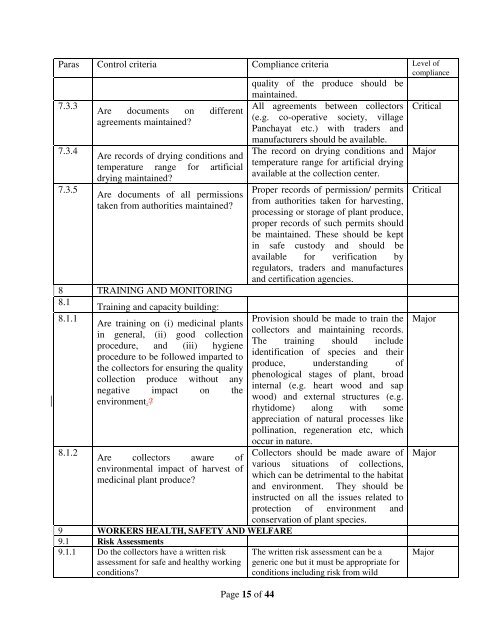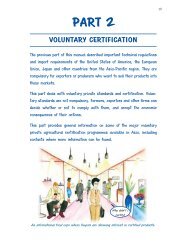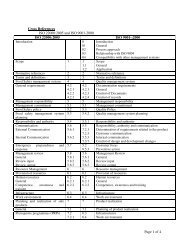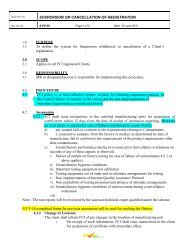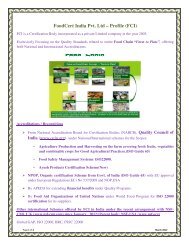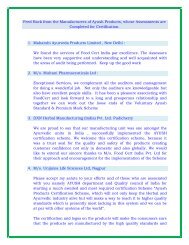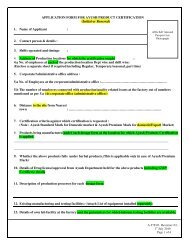Standard for Good Field Collection Practices - NMPB
Standard for Good Field Collection Practices - NMPB
Standard for Good Field Collection Practices - NMPB
You also want an ePaper? Increase the reach of your titles
YUMPU automatically turns print PDFs into web optimized ePapers that Google loves.
Paras Control criteria Compliance criteria Level of<br />
compliance<br />
quality of the produce should be<br />
maintained.<br />
7.3.3<br />
7.3.4<br />
7.3.5<br />
Are documents on different<br />
agreements maintained?<br />
Are records of drying conditions and<br />
temperature range <strong>for</strong> artificial<br />
drying maintained?<br />
Are documents of all permissions<br />
taken from authorities maintained?<br />
8 TRAINING AND MONITORING<br />
8.1<br />
Training and capacity building:<br />
8.1.1<br />
Are training on (i) medicinal plants<br />
in general, (ii) good collection<br />
procedure, and (iii) hygiene<br />
procedure to be followed imparted to<br />
the collectors <strong>for</strong> ensuring the quality<br />
collection produce without any<br />
negative impact on the<br />
environment.?<br />
8.1.2<br />
Are collectors aware of<br />
environmental impact of harvest of<br />
medicinal plant produce?<br />
9 WORKERS HEALTH, SAFETY AND WELFARE<br />
9.1 Risk Assessments<br />
9.1.1 Do the collectors have a written risk<br />
assessment <strong>for</strong> safe and healthy working<br />
conditions?<br />
Page 15 of 44<br />
All agreements between collectors<br />
(e.g. co-operative society, village<br />
Panchayat etc.) with traders and<br />
manufacturers should be available.<br />
The record on drying conditions and<br />
temperature range <strong>for</strong> artificial drying<br />
available at the collection center.<br />
Proper records of permission/ permits<br />
from authorities taken <strong>for</strong> harvesting,<br />
processing or storage of plant produce,<br />
proper records of such permits should<br />
be maintained. These should be kept<br />
in safe custody and should be<br />
available <strong>for</strong> verification by<br />
regulators, traders and manufactures<br />
and certification agencies.<br />
Provision should be made to train the<br />
collectors and maintaining records.<br />
The training should include<br />
identification of species and their<br />
produce, understanding of<br />
phenological stages of plant, broad<br />
internal (e.g. heart wood and sap<br />
wood) and external structures (e.g.<br />
rhytidome) along with some<br />
appreciation of natural processes like<br />
pollination, regeneration etc, which<br />
occur in nature.<br />
Collectors should be made aware of<br />
various situations of collections,<br />
which can be detrimental to the habitat<br />
and environment. They should be<br />
instructed on all the issues related to<br />
protection of environment and<br />
conservation of plant species.<br />
The written risk assessment can be a<br />
generic one but it must be appropriate <strong>for</strong><br />
conditions including risk from wild<br />
Critical<br />
Major<br />
Critical<br />
Major<br />
Major<br />
Major


